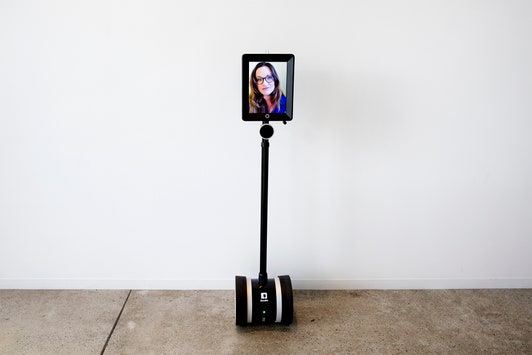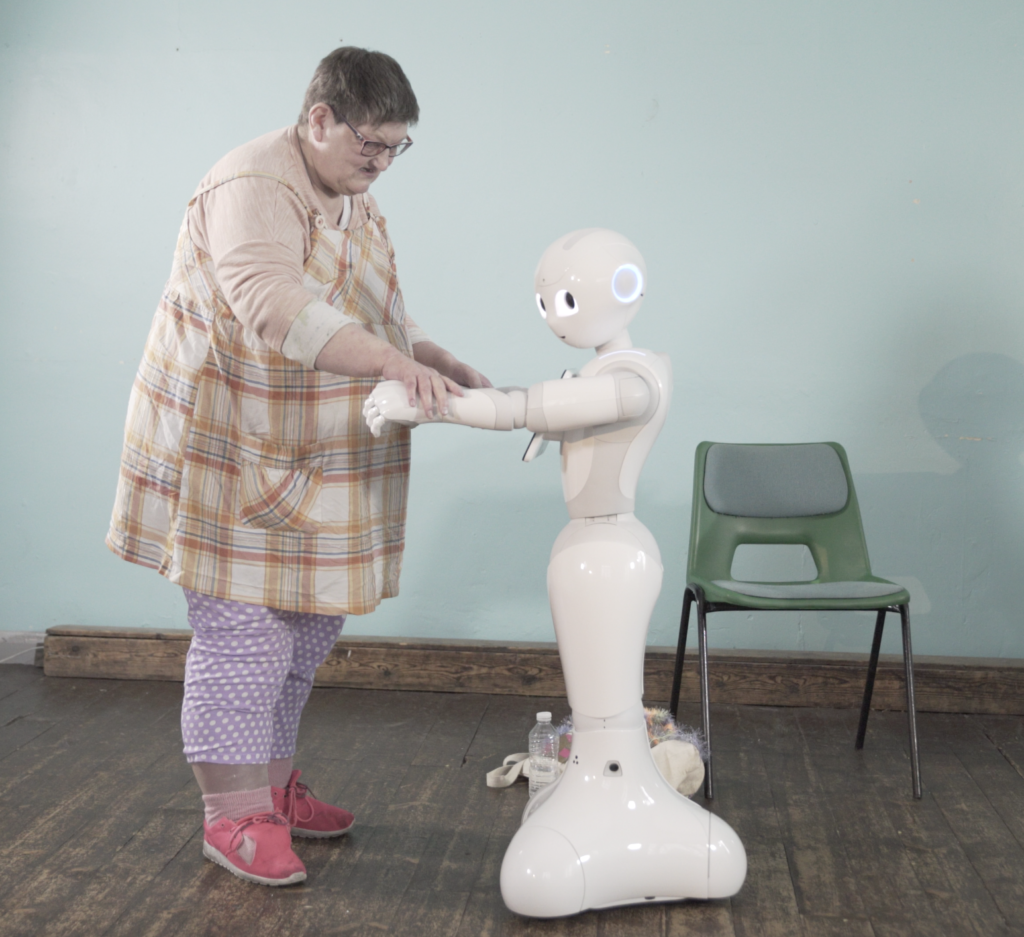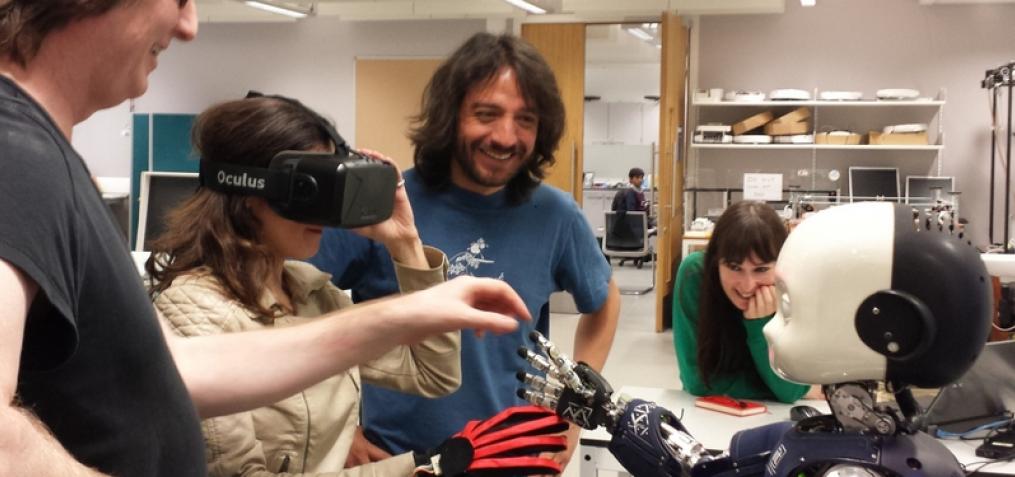Photo: Michael Szollosy
Robots, Telepresence, and Covid-19
The pressures and challenges of Covid-19 have seen rapid development and deployment of new technologies, particularly in health care, as people search for new ways of doing things that keep humans safe and secure during a global pandemic. Robots could be an important solution to help us out of this crisis: they offer a chance for jobs to be done without the risk of staff being contaminated, or transmitting the virus. In one Wuhan hospital, for example, robots are being used to help treat patients, and robots are being used elsewhere in China to disinfect hospitals.
The lockdowns that are intended to mitigate the dangers of contamination, particularly of vulnerable groups such as the elderly and those with pre-existing health conditions, are creating another set of problems for which many are looking to new technologies for answers. The vital importance of human communications – and contact – cannot be underestimated at such a critical time.
We have therefore seen the last few months an acceleration of technologies that promise to enhance existing telecommunications technologies, such as a massive uptake in services such as Zoom and improved offerings from some of the big players already in the market, such as Facebook’s Portal and additional functionality from services like Google’s Meet.
But the really interesting developments, certainly for our itDf researchers, are the ambitious attempts to bring robots and more immersive telepresence technologies into social and health care, in an attempt to bridge the gaping hole left by the lack of human contact in a lockdown world.
Some of these ‘robots’ are little more than upgrades on the flat-screen teleconferencing of Portal, Zoom, etc., but we shouldn’t be quick to dismiss how such offerings can provide more rewarding communications; research shows that even simple telepresence systems can help overcome isolation for elderly patients in care.

Some trials are underway, however, which try to use more sophisticated, humanoid robots in care homes, such as this one in the UK and Japan which uses Softbank’s Pepper robot. Such trials are using autonomous robots to supplement (never ‘replace’) human care.
Another use of robots in care involves telepresence, the feeling of actually being present in a remote location. Using telepresence, careworkers, family and friends can ‘visit’ Covid-vulnerable persons, using a robot to enhance the experience. On one level, teleconferencing services such as Zoom offer a form of telepresence; however, more sophisticated technologies, leveraging humanoid robots, help create more immersive experience.
Immersion refers to the extent to which one feels present in the remote environment: flat-screen teleconferencing services such as Zoom provide very low levels of immersion. However, new technologies have made it possible to create much more immersive experiences: using more sophisticated humanoid robots and technologies such as virtual reality, haptics, and low-latency communications, users can have a much more compelling experience, feeling much more as though they are present in the remote location.
Because such telepresence systems are so much more engaging and offer new and more powerful human-computer interactions, researchers and industry alike are keen to explore the possibilities of highly-immersive technologies for communications and remote working. Beyond just pretending we’re in the office, highly-immersive telepresence robots can transform the way we do jobs, as users can have an actual physical presence in the remote location, and the power to interact in that environment in a concrete way. (Such as the example of the robots disinfecting hospitals in China, described above). Immersive telepresence also means that human remote communications can be much more emotionally rewarding, so their potential use in care could be transformative: by ‘visiting’ relatives through a robot placed in a care home, for example, both the users controlling the robot and those in care can feel much more engaged in the experience in a way that goes far beyond the limited experience of flat-screen communications and the limited engagements offered by autonomous robotics.
Fully immersive telepresence experiences are being sought after as an important future technology. The promise of such technologies is great, and one that has long been fantastised about in human culture: the opportunity to transcend the limitations of the physical human body. Such technologies have long been the stuff of religious fantasy and, more recently, science fiction, including the legendary William Gibson’s latest novels, The Peripheral and The Agency, which we’re reading.

(If you’d like to follow the fiction that we’re reading as part of the itDf project, have a look at the bookshelf on our website, or follow us in our Goodreads group.)
But more realistically (perhaps), fully-immersive telepresence allows us to radically change the shape of work and social relations, allowing easier access to distant geographic locations and expertise, allowing us to bridge the gap between vast distances, cultures and even time.
Here at ITDF we are researching more immersive forms of telepresence, to see how such immersive technologies can impact disability, and our perceptions of it. We have already done some work in this area: for example, see itDf project-member Luna Dolezal’s excellent paper on the phenomenology of telepresence and re-embodiment.
One of the key challenges that would have tremendous impacts on care is the introduction of touch as a sensory modality in immersive telepresence. Perhaps unsurprisingly, human touch is hard to replicate through technology, but studies show that touch can have a vital role to play in expressing emotion through telepresence communicative technologies.

At itDf, we are planning a workshop on Affective Technotouch in conjunction with the Brocher Foundation (scheduled for 21 – 23 November 2021). Through this workshop, we will consider how roboticists might incorporate a sensitivity to nuanced, context-specific embodied touch, and its relation to experiences of vulnerability, care, risk, affect and power, into care robot design. Themes will include robot touch and the neuroscience of human/robot encounters, designing caring touch, and the ethics of telepresence and touch, addressing power and vulnerability: asymmetrical embodiment and robot design.
(We’ll send more information out on this in a future post. Follow our ‘telepresence’ tag to read related posts in this series.)
If you’d like any more information on our activities or research related to touch or telepresence, please do get in touch, or follow us on twitter for future updates.

